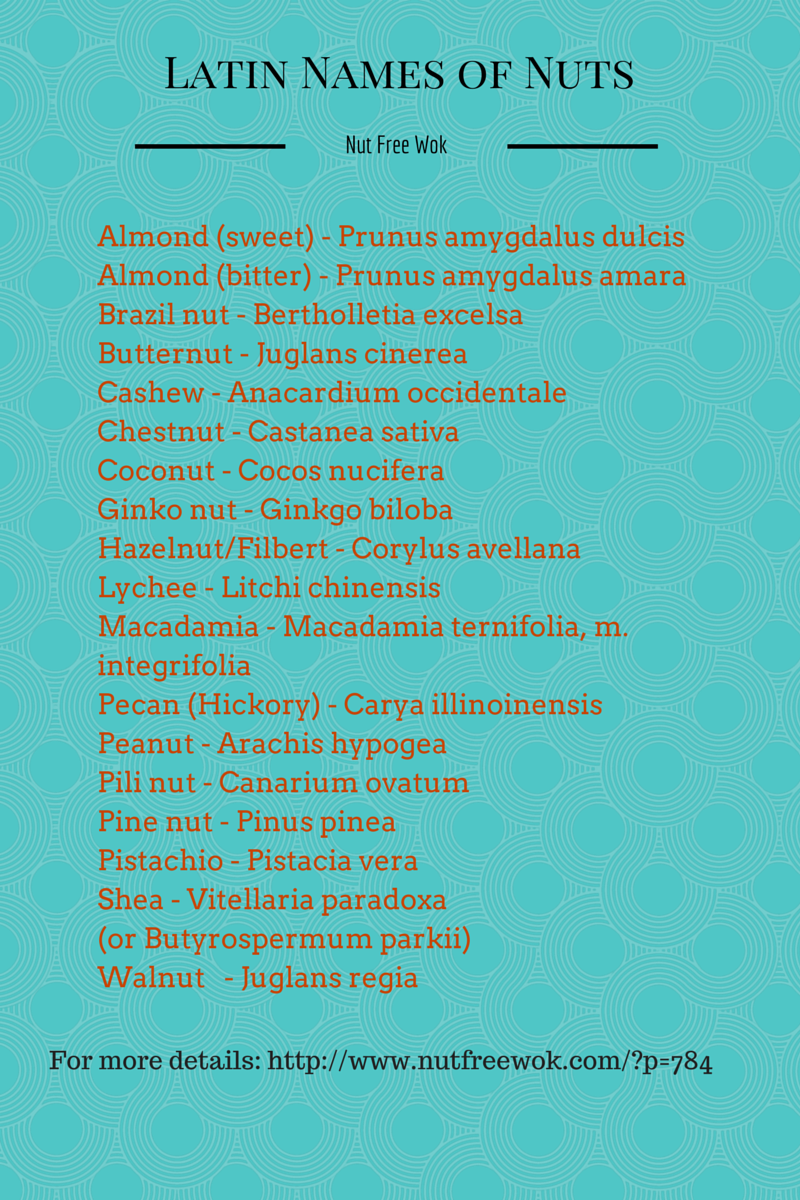
Familiarizing ourselves with the Latin names or roots will help us identify top allergens in non-food product ingredient labels. As of January 6, 2025, the FDA has published their Final Guidance for Industry: Questions and Answers Regarding Food Allergens, Including the Food Allergen Labeling Requirements of the Federal Food, Drug, and Cosmetic Act (Edition 5). I will update this post as soon as possible, but please read the document in the meantime.
Disclaimer: Please check that all ingredients are suitable for your allergies and be sure to ask your medical care team regarding any allergy related questions (I do not share medical advice). As an Amazon Associate, I earn from qualifying purchases.
Not a great way to start a vacation…
If only someone had told me that it is important to know the Latin names for food allergens. On our very first full day of our vacation in Hawaii many years ago, my husband and I diligently applied sunblock on our children’s arms and legs so that they would not be sunburned from our day’s adventure.
Imagine my horror of seeing one of my boys covered from head to toes in hives! We had no idea what happened or why but I rushed back to our hotel room with my little guy, gave him Benadryl, washed off all the sunblock, and applied cold compresses while watching him carefully while he slept off the antihistamines. No more sunblock for the rest of the trip!!
Lesson learned!
It didn’t occur to me that the hives could have been a food allergy related issue and went to see our dermatologist about the incident who advised that he could have been allergic to any of the chemicals in the sunblock, so it’s best to minimize our usage of sunblock in general and use only zinc oxide or titanium oxide based sunscreens. Eventually I found Vanicream sunblock which is very hypoallergenic and works for our family.
But not knowing what happened and why bothered me for years. It wasn’t until I searched online that l discovered that both types of sunblocks we used caused problems for other people with peanut allergy possibly due to an ingredient called “arachidyl propionate.” When I called the manufacturers, they denied that the chemical was derived from peanuts (Latin name Arachis hypogea). Since I had long since thrown away the product, I didn’t pursue the issue and continue to avoid any products that have an ingredient that is similar to Arachis.
Why have a list of Latin names?
Top 9 food allergens are required to be listed in food products using clear and easy to understand English. However, non-food products such as shampoos, lotions, make up, medication, etc. do not have the same requirement. Ingredients may be listed using a scientific name. This Latin list may be helpful when traveling internationally, especially in countries with languages based on Latin or which use scientific names.
A list of Latin names of some common food allergens that allows me to cross reference whether an ingredient might be derived from a food allergen. My friend Dani asked me to share my list recently, which I did but later decided to update the readability of the list and add a few more allergens.
Latin names of common food allergens:
I have included peanuts and tree nuts, some of our family’s allergens, and some foods that are commonly used in products but this list is by no means comprehensive, please ask your medical professional if you have any questions.
If you want to look up the Latin names of other foods, I was able to find a lot of great information via the InformAll Allergenic Database. I’ve created some graphics that you can copy and save from Nut Free Wok’s Facebook page: Latin Names for Peanuts and Tree Nuts, Latin Names for Allergens in Products.
Unexpected Food Allergens
Lupine: People with a peanut allergy need to be aware that lupine (lupin albus) has been associated with allergic reactions. Lupine is more commonly used in Europe and often found in gluten-free products. “Lupine seed, also known as the Lupinus species, is cross-reactive with other members of the legume Fabaceae family: peanut, pea, chickpea, lentil, soybean, and beans.”
Non-edible tree nuts: I found the FDA’s official list of tree nuts, which includes some non-edible tree nuts that might have some non-food use. As the list is growing, I highlighted the nuts in a brownish nutty color (even though I want to highlight them in RED!).
- Almond (sweet) – Prunus amygdalus dulcis
- Almond (bitter) — Prunus amygdalus amara
- Apple – Malus domestica
- Apricot – Prunus armeniaca
- Avocado – Persea americana, P. gratissima
- Banana – Musa acuminata; Musa balbisiana(hybrid)
- Barley – Hordeum vulgare
- Bell pepper – Capsicum annuum
- Brazil nut – Bertholletia excelsa
- Buckwheat – Fagopyrum esculentum
- Butternut – Juglans cinerea
- Camomile – Matricaria chamomilla
- Cashew – Anacardium occidentale
- Celery – Apium graveolens
- Chestnut – Castanea sativa and other Castanea species
- Chickpea – Cicer arietinum
- Coconut – Cocos nucifera
- Corn – Zea mays
- Crab – Castanea sativa
- Egg – Ovum (hen’s egg – Gallus Gallus domesticus)
- Ginko nut – Ginkgo biloba
- Hazelnut/Filbert – Corylus avellana
- Kiwi fruit – Actinidia deliciosa (green), A. arguta (baby), A. chinensis (gold)
- Lobster – Homarus americanus
- Lupin – Lupinus Albus
- Lychee – Litchi chinensis
- Macadamia/Bush nut – Macadamia ternifolia, m. integrifolia
- Mango – Mangifera indica
- Milk – lac (cow’s milk – Bos taurus)
- Mustard – Brassica nigra, Sinapis alba
- Oat – Avena sativa
- Peach – Prunus persica
- Pecan (Hickory) – Carya illinoinensis
- Peanut – Arachis hypogea
- Pili nut – Canarium ovatum
- Pine nut — Pinus pinea
- Pistachio – Pistacia vera
- Rice – Oryza sativa
- Sesame – Sesamum indicum
- Shea – Vitellaria paradoxa (Butyrospermum parkii)
- Soy – Glycine max, Dolichos soja
- Squid – Todarodes pacificus
- Sunflower – Helianthus annuus
- Tomato – Lycopersicon esculentum
- Walnut – Juglans regia and other Juglan species
- Wheat – Triticum aestivum, T. durum and other Triticum species
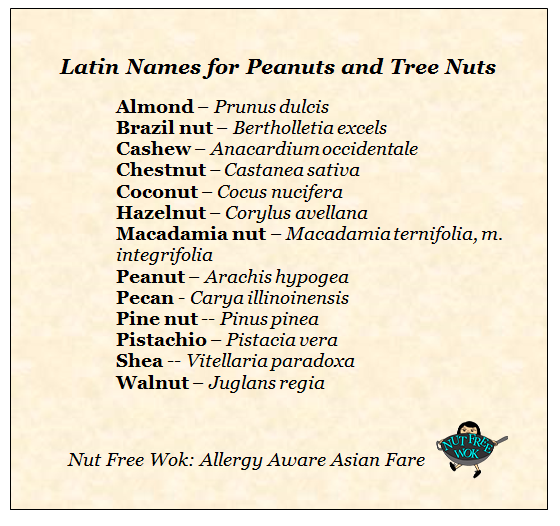
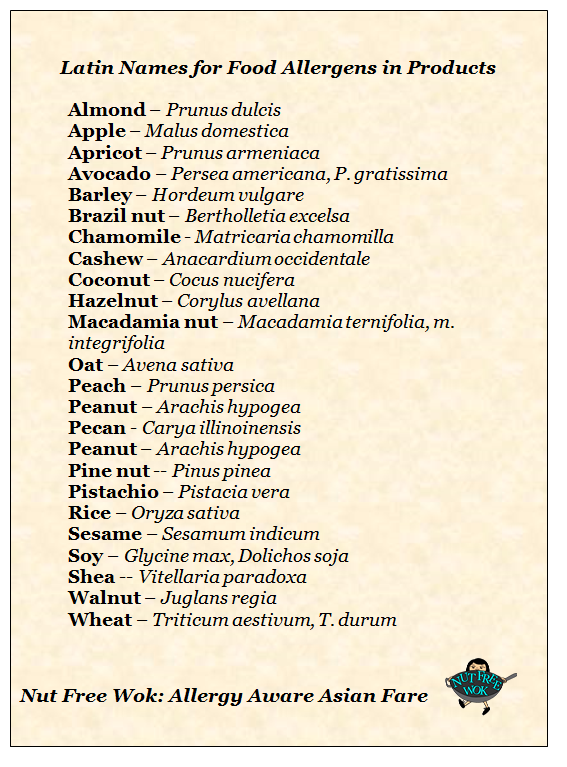
Thanks for reading, please help Nut Free Wok!
If you like this post or recipe, please be sure to give a 5 star rating, leave a comment, and share this post! Your support means a lot to me.
Subscribe to Nut Free Wok’s email subscription (be sure to respond to the confirmation email). You will be notified by email next time I publish another post or recipe and I won’t send you spam or share your email address with anyone.
Disclosure/Disclaimer:
I may mention the names of stores and/or brand names of products that I use because readers ask and I share products and sources which I use and think may be helpful to readers, all opinions are my own. Please note that manufacturing practices and ingredients can change at anytime without notice and readers are always responsible for assuring allergen safety before buying or consuming foods. NutFreeWok.com is a participant in the Amazon Services LLC Associates Program, an affiliate advertising program designed to provide a means for sites to earn advertising fees by advertising and linking to Amazon.com. Thank you for reading!
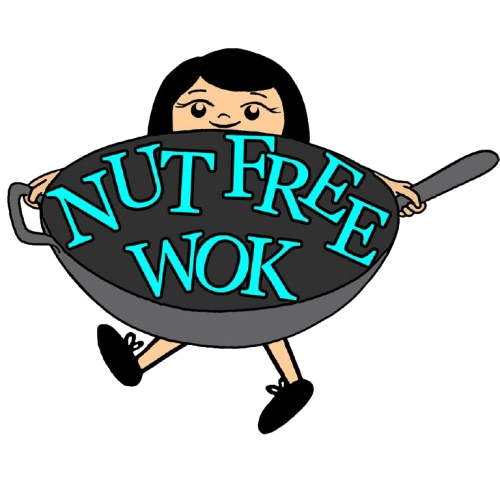
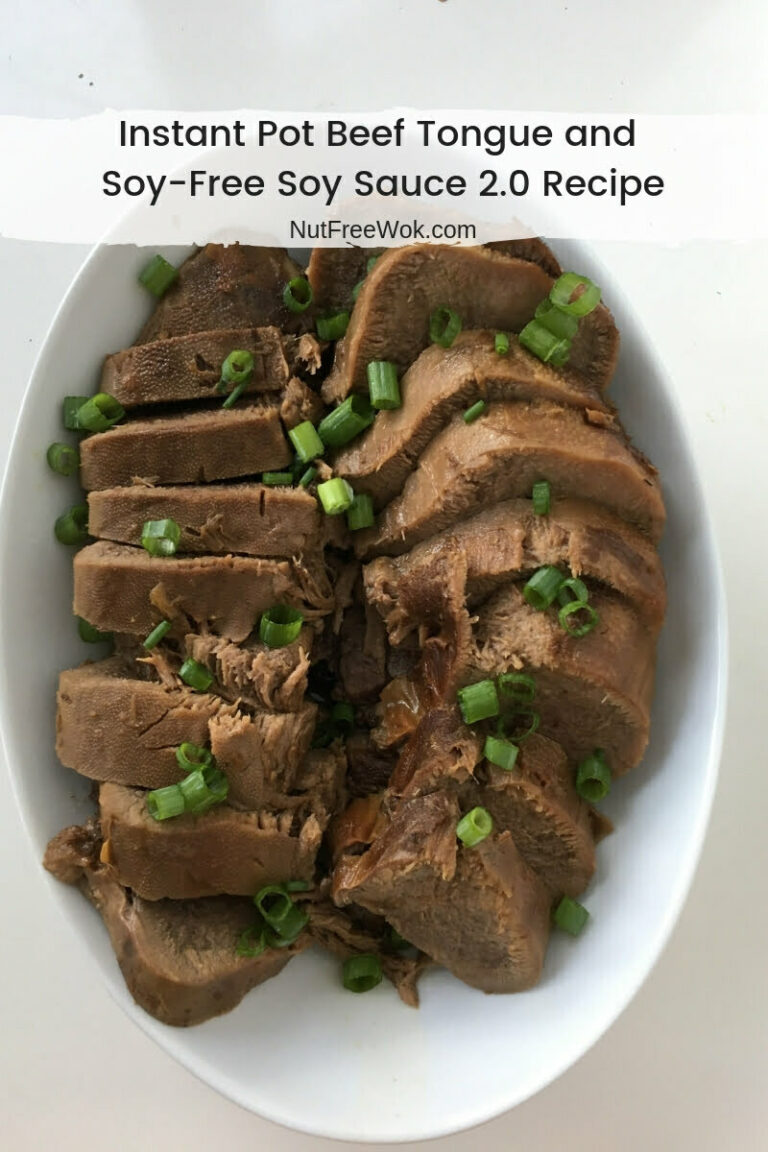
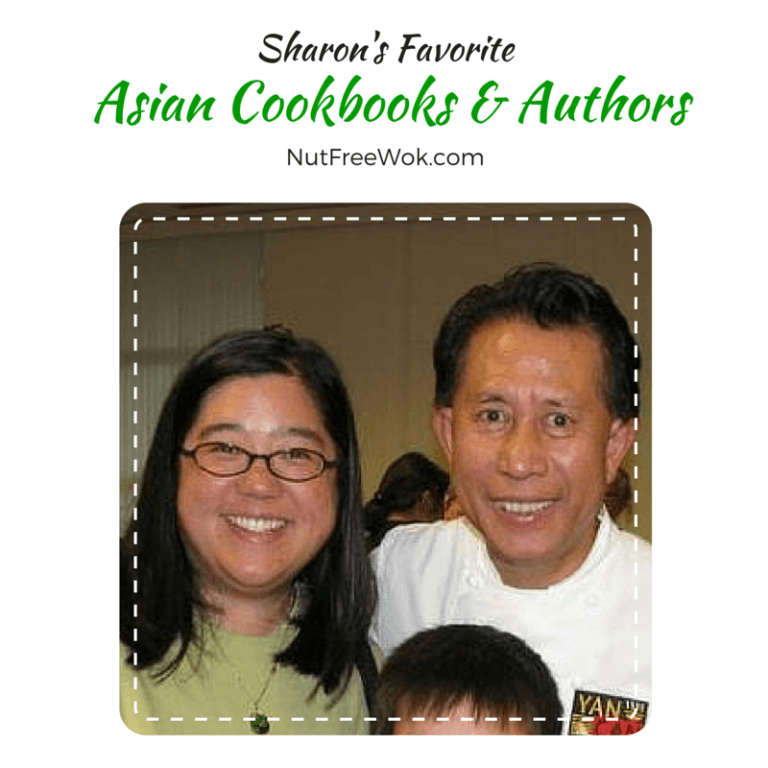
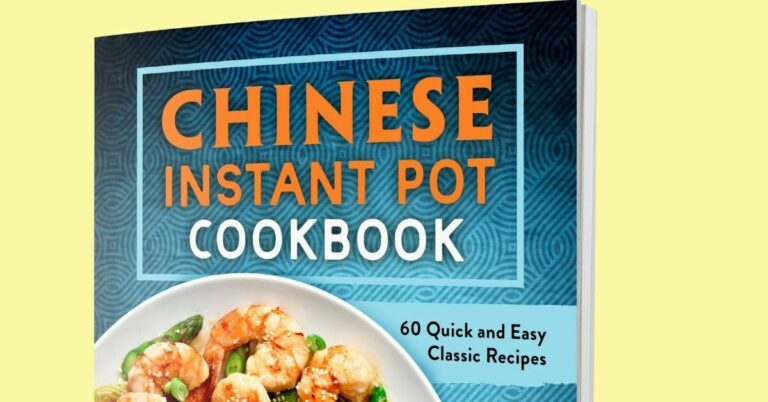
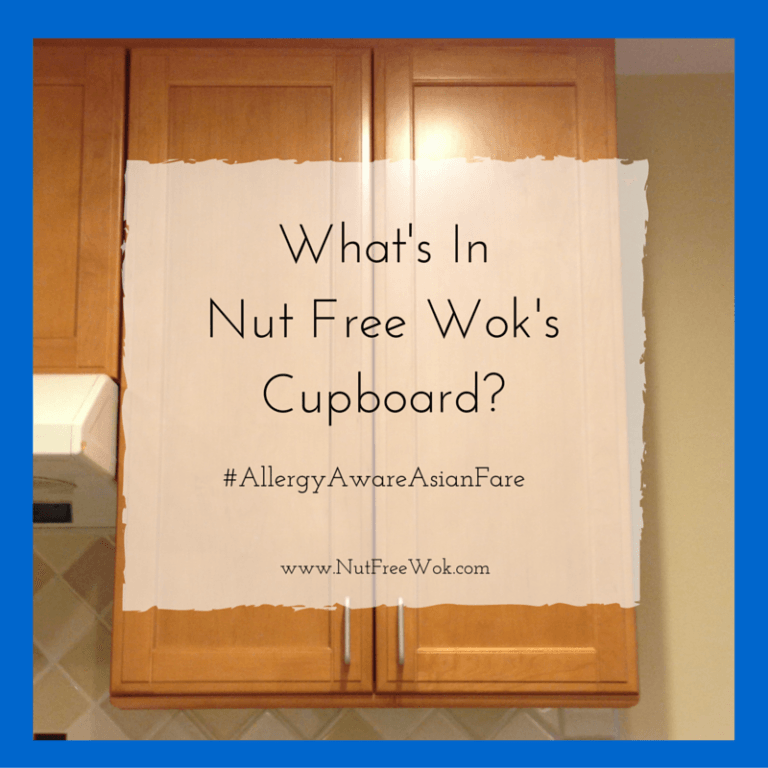
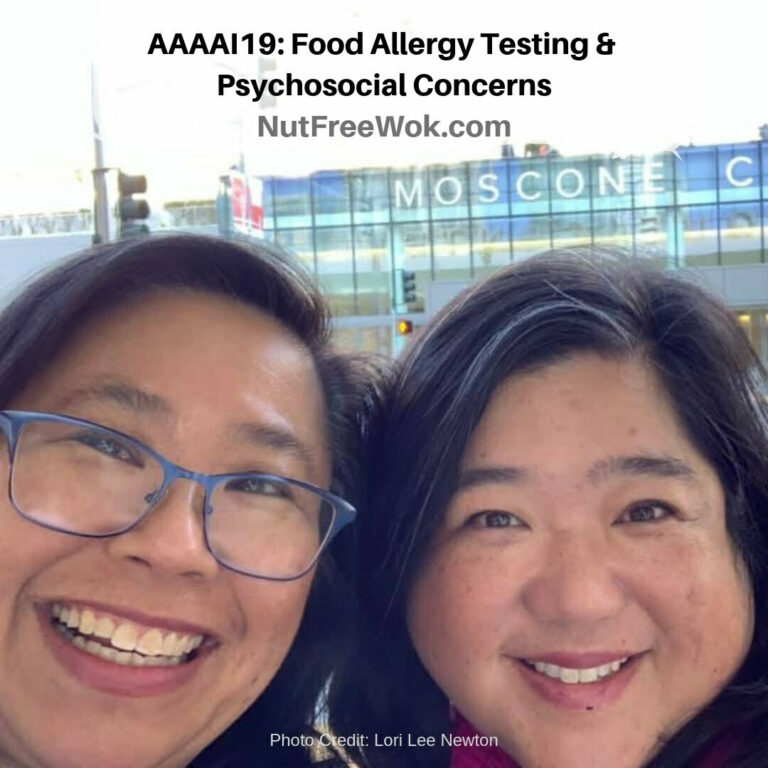
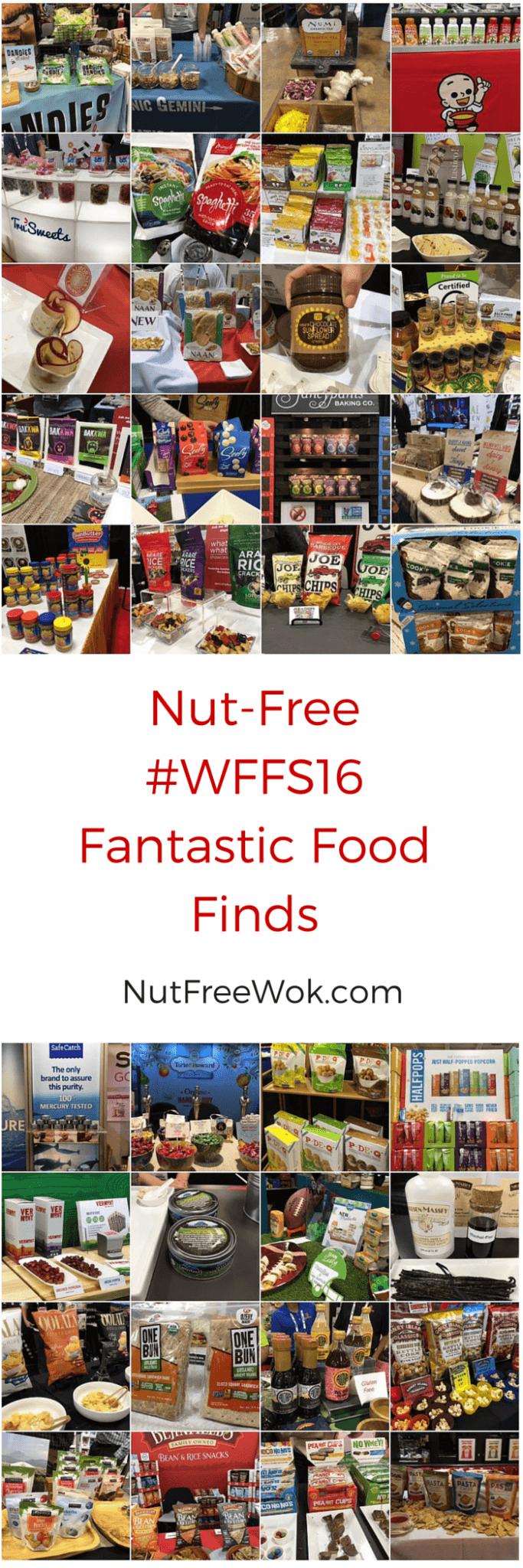
Just to add on, these are some of the less obvious names for milk-based ingredients:
Casein or caseinates
Diacetyl
Hydrolysates
Lactalbumin, lactalbumin phosphate
Lactose, lactoglobulin, lactoferrin, lactulose
Whey
Thank you so much!! Great suggestions
Thank you for sharing this post. Very informative.
Thank you, I’m glad it’s helpful!!
Coconut is not a tree nut. It is a drupe; a fruit, even though the Food and Drug Administration calls coconut a tree nut. While allergic reactions to coconut have been documented, most people who are allergic to tree nuts can safely eat coconut.
Agree 100%.
Thank you so much. I thought I was crazy I’m allergic to nuts. I showered with a new shampoo began to burn hives it looked like I had sun burn, I too had to take benadryl. I called the manufacture they denied. I clearly told them they must label their product like food makers do with warnings may contain or processed in machienety with nuts. They sent me coupons to buy more what a joke.
Oh Mama4! I’m so sorry you had that reaction from the shampoo. What was the ingredient name and what product do you think caused your reaction? I wonder if you can share what happened with the FDA? I would hope that if more people share their stories, they will look into addressing this need to label food ingredients used in non-food items.
Thank you so much for sharing all these information!
I do have a question about Lychee. I didn’t realized it is a tree nut or that people eat the “seed part”. My kids are TN/PN/Shellfish FA. They have enjoyed lychee a lot both in their fresh and canned forms. Also ginkgo?
I did a quick search and learned something new! Lychee seeds taste terrible but they are ground up to use for medicinal purposes (evidence for its effectiveness is limited). It’s probably best to consult with your doctor about whether or not to continue eating ginko and lychee fruit. My guess is that if those foods are tolerated, then continue but exercise caution about cross-contact due to processing. One of my sons is allergic to the fruit of lychee and longan but the other son is not and can eat them without symptoms or restrictions. Go figure, food allergies are so complicated! Thank you for visiting and taking the time to comment!